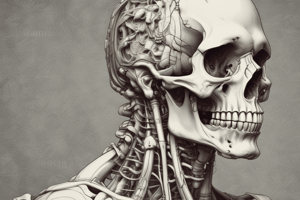Podcast
Questions and Answers
What is the percentage of organic material in bones?
What is the percentage of organic material in bones?
- 65%
- 35% (correct)
- 50%
- 20%
What is the primary function of cancellous bone?
What is the primary function of cancellous bone?
- Support (correct)
- Protection
- Movement
- Storage
Which type of bone is characterized by a shaft and two ends?
Which type of bone is characterized by a shaft and two ends?
- Short bone
- Long bone (correct)
- Flat bone
- Irregular bone
What is the process of bone formation?
What is the process of bone formation?
What is the function of bone marrow?
What is the function of bone marrow?
What is the term for bone growth that occurs through the growth plate?
What is the term for bone growth that occurs through the growth plate?
Flashcards are hidden until you start studying
Study Notes
Composition
- Bones are composed of:
- Organic material (35%): collagen, a protein that gives bone its flexibility
- Inorganic material (65%): hydroxyapatite, a mineral that gives bone its hardness and rigidity
Structure
- Bones have a compact outer layer (cortical bone) and a spongy inner layer (cancellous bone)
- Cortical bone is dense and compact, making up 80% of adult bone mass
- Cancellous bone is porous and lightweight, making up 20% of adult bone mass
Functions
- Support: provide a framework for the body
- Protection: protect internal organs, such as the brain and heart
- Movement: serve as attachment points for muscles
- Blood cell production: bone marrow produces blood cells
- Storage: store minerals such as calcium and phosphorus
- Endocrine function: regulate mineral homeostasis and hormone production
Types of Bones
- Long bones: characterized by a shaft (diaphysis) and two ends (epiphyses)
- Short bones: cube-shaped and approximately equal in length, width, and height
- Flat bones: thin and flat, often curved
- Irregular bones: complex shapes that do not fit into other categories
- Sesamoid bones: small, round bones embedded within tendons
Bone Development and Growth
- Ossification: the process of bone formation
- Endochondral ossification: bone formation from cartilage models
- Intramembranous ossification: bone formation from mesenchymal tissue
- Bone growth: occurs through the growth plate, a layer of cartilage at the end of long bones
Composition of Bones
- 35% of bone is composed of organic material, primarily collagen, which provides flexibility
- 65% of bone is composed of inorganic material, primarily hydroxyapatite, which provides hardness and rigidity
Structure of Bones
- Bones have a compact outer layer called cortical bone, which makes up 80% of adult bone mass
- Bones have a spongy inner layer called cancellous bone, which makes up 20% of adult bone mass
- Cortical bone is dense and compact, while cancellous bone is porous and lightweight
Functions of Bones
- Bones provide a framework for the body and support its overall structure
- Bones protect internal organs, such as the brain and heart
- Bones serve as attachment points for muscles, enabling movement
- Bones are responsible for producing blood cells through the bone marrow
- Bones store minerals such as calcium and phosphorus
- Bones regulate mineral homeostasis and hormone production through endocrine function
Classification of Bones
- Long bones have a shaft (diaphysis) and two ends (epiphyses)
- Short bones are cube-shaped and approximately equal in length, width, and height
- Flat bones are thin and flat, often curved
- Irregular bones have complex shapes that do not fit into other categories
- Sesamoid bones are small, round bones embedded within tendons
Bone Development and Growth
- Ossification is the process of bone formation
- Endochondral ossification is the process of bone formation from cartilage models
- Intramembranous ossification is the process of bone formation from mesenchymal tissue
- Bone growth occurs through the growth plate, a layer of cartilage at the end of long bones
Studying That Suits You
Use AI to generate personalized quizzes and flashcards to suit your learning preferences.




